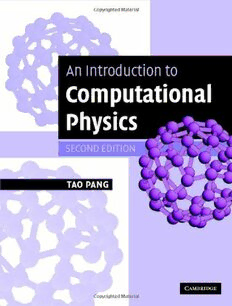Table Of ContentAn Introduction to Computational Physics
Numericalsimulationisnowanintegratedpartofscienceandtechnology.Now
initssecondedition,thiscomprehensivetextbookprovidesanintroductionto
thebasicmethodsofcomputationalphysics,aswellasanoverviewofrecent
progressinseveralareasofscientificcomputing.Theauthorpresentsmany
step-by-stepexamples,includingprogramlistingsinJavaTM,ofpractical
numericalmethodsfrommodernphysicsandareasinwhichcomputational
physicshasmadesignificantprogressinthelastdecade.
Thefirsthalfofthebookdealswithbasiccomputationaltoolsandroutines,
coveringapproximationandoptimizationofafunction,differentialequations,
spectralanalysis,andmatrixoperations.Importantconceptsareillustratedby
relevantexamplesateachstage.Theauthoralsodiscussesmoreadvanced
topics,suchasmoleculardynamics,modelingcontinuoussystems,Monte
Carlomethods,thegeneticalgorithmandprogramming,andnumerical
renormalization.
Thisneweditionhasbeenthoroughlyrevisedandincludesmanymore
examplesandexercises.Itcanbeusedasatextbookforeitherundergraduateor
first-yeargraduatecoursesoncomputationalphysicsorscientificcomputation.
Itwillalsobeausefulreferenceforanyoneinvolvedincomputationalresearch.
TaoPangisProfessorofPhysicsattheUniversityofNevada,LasVegas.
FollowinghishighereducationatFudanUniversity,oneofthemostprestigious
institutionsinChina,heobtainedhisPh.D.incondensedmattertheoryfromthe
UniversityofMinnesotain1989.HethenspenttwoyearsasaMillerResearch
FellowattheUniversityofCalifornia,Berkeley,beforejoiningthephysics
facultyattheUniversityofNevada,LasVegasinthefallof1991.Hehasbeen
ProfessorofPhysicsatUNLVsince2002.Hismainareasofresearchinclude
condensedmattertheoryandcomputationalphysics.
An Introduction to
Computational Physics
Second Edition
Tao Pang
University of Nevada, Las Vegas
cambridge university press
Cambridge, New York, Melbourne, Madrid, Cape Town, Singapore, São Paulo
Cambridge University Press
cb2 2ru
The Edinburgh Building, Cambridge , UK
Published in the United States of America by Cambridge University Press, New York
www.cambridge.org
Informationo nthi stitle :www.cambri dge.org/9780521825696
© T. Pang 2006
This publication is in copyright. Subject to statutory exception and to the provision of
relevant collective licensing agreements, no reproduction of any part may take place
without the written permission of Cambridge University Press.
First published in print format 2006
isbn-13 978-0-511-14046-4
eBook (NetLibrary)
isbn-10 0-511-14046-0
eBook (NetLibrary)
isbn-13 978-0-521-82569-6
hardback
isbn-10 0-521-82569-5
hardback
isbn-13 978-0-521-53276-1
isbn-10 0-521-53276-0
url
Cambridge University Press has no responsibility for the persistence or accuracy of s
for external or third-party internet websites referred to in this publication, and does not
guarantee that any content on such websites is, or will remain, accurate or appropriate.
ToYunhua,forenduringlove
Contents
Prefacetofirstedition xi
Preface xiii
Acknowledgments xv
1 Introduction 1
1.1 Computationandscience 1
1.2 Theemergenceofmoderncomputers 4
1.3 Computeralgorithmsandlanguages 7
Exercises 14
2 Approximationofafunction 16
2.1 Interpolation 16
2.2 Least-squaresapproximation 24
2.3 TheMillikanexperiment 27
2.4 Splineapproximation 30
2.5 Random-numbergenerators 37
Exercises 44
3 Numericalcalculus 49
3.1 Numericaldifferentiation 49
3.2 Numericalintegration 56
3.3 Rootsofanequation 62
3.4 Extremesofafunction 66
3.5 Classicalscattering 70
Exercises 76
4 Ordinarydifferentialequations 80
4.1 Initial-valueproblems 81
4.2 TheEulerandPicardmethods 81
4.3 Predictor–correctormethods 83
4.4 TheRunge–Kuttamethod 88
4.5 Chaoticdynamicsofadrivenpendulum 90
4.6 Boundary-valueandeigenvalueproblems 94
vii
viii Contents
4.7 Theshootingmethod 96
4.8 LinearequationsandtheSturm–Liouvilleproblem 99
4.9 Theone-dimensionalSchro¨dingerequation 105
Exercises 115
5 Numericalmethodsformatrices 119
5.1 Matricesinphysics 119
5.2 Basicmatrixoperations 123
5.3 Linearequationsystems 125
5.4 Zerosandextremesofmultivariablefunctions 133
5.5 Eigenvalueproblems 138
5.6 TheFaddeev–Leverriermethod 147
5.7 Complexzerosofapolynomial 149
5.8 Electronicstructuresofatoms 153
5.9 TheLanczosalgorithmandthemany-bodyproblem 156
5.10 Randommatrices 158
Exercises 160
6 Spectralanalysis 164
6.1 Fourieranalysisandorthogonalfunctions 165
6.2 DiscreteFouriertransform 166
6.3 FastFouriertransform 169
6.4 Powerspectrumofadrivenpendulum 173
6.5 Fouriertransforminhigherdimensions 174
6.6 Waveletanalysis 175
6.7 Discretewavelettransform 180
6.8 Specialfunctions 187
6.9 Gaussianquadratures 191
Exercises 193
7 Partialdifferentialequations 197
7.1 Partialdifferentialequationsinphysics 197
7.2 Separationofvariables 198
7.3 Discretizationoftheequation 204
7.4 Thematrixmethodfordifferenceequations 206
7.5 Therelaxationmethod 209
7.6 Groundwaterdynamics 213
7.7 Initial-valueproblems 216
7.8 Temperaturefieldofanuclearwasterod 219
Exercises 222
8 Moleculardynamicssimulations 226
8.1 Generalbehaviorofaclassicalsystem 226
Contents ix
8.2 Basicmethodsformany-bodysystems 228
8.3 TheVerletalgorithm 232
8.4 Structureofatomicclusters 236
8.5 TheGearpredictor–correctormethod 239
8.6 Constantpressure,temperature,andbondlength 241
8.7 Structureanddynamicsofrealmaterials 246
8.8 Abinitiomoleculardynamics 250
Exercises 254
9 Modelingcontinuoussystems 256
9.1 Hydrodynamicequations 256
9.2 Thebasicfiniteelementmethod 258
9.3 TheRitzvariationalmethod 262
9.4 Higher-dimensionalsystems 266
9.5 Thefiniteelementmethodfornonlinearequations 269
9.6 Theparticle-in-cellmethod 271
9.7 Hydrodynamicsandmagnetohydrodynamics 276
9.8 ThelatticeBoltzmannmethod 279
Exercises 282
10 MonteCarlosimulations 285
10.1 Samplingandintegration 285
10.2 TheMetropolisalgorithm 287
10.3 Applicationsinstatisticalphysics 292
10.4 Criticalslowingdownandblockalgorithms 297
10.5 VariationalquantumMonteCarlosimulations 299
10.6 Green’sfunctionMonteCarlosimulations 303
10.7 Two-dimensionalelectrongas 307
10.8 Path-integralMonteCarlosimulations 313
10.9 Quantumlatticemodels 315
Exercises 320
11 Geneticalgorithmandprogramming 323
11.1 Basicelementsofageneticalgorithm 324
11.2 TheThomsonproblem 332
11.3 Continuousgeneticalgorithm 335
11.4 Otherapplications 338
11.5 Geneticprogramming 342
Exercises 345
12 Numericalrenormalization 347
12.1 Thescalingconcept 347
12.2 Renormalizationtransform 350

